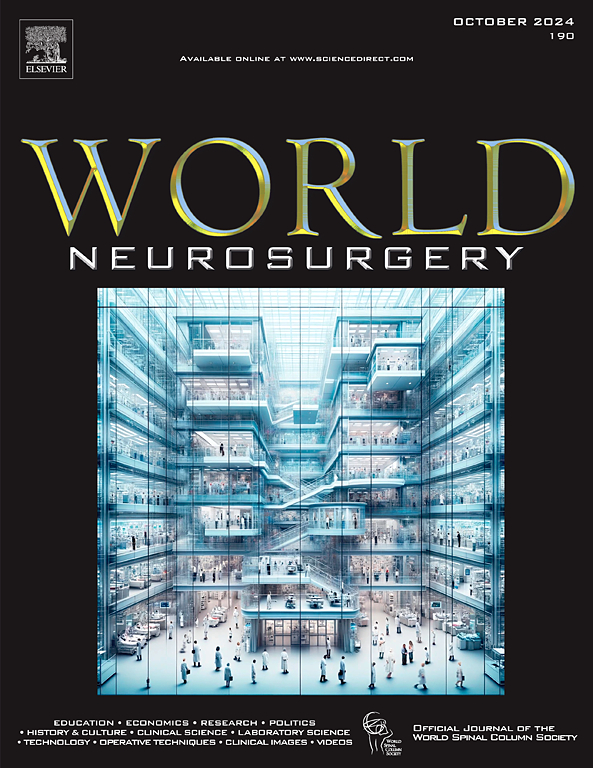Artificial Intelligence–Based Radiomic Model in Craniopharyngiomas: A Systematic Review and Meta-Analysis on Diagnosis, Segmentation, and Classification
IF 1.9
4区 医学
Q3 CLINICAL NEUROLOGY
引用次数: 0
Abstract
Background
Craniopharyngiomas (CPs) are rare, benign brain tumors originating from Rathke's pouch remnants, typically located in the sellar/parasellar region. Accurate differentiation is crucial due to varying prognoses, with adamantinomatous CPs having higher recurrence and worse outcomes. Magnetic resonance imaging struggles with overlapping features, complicating diagnosis. This study evaluates the role of artificial intelligence (AI) in diagnosing, segmenting, and classifying CPs, emphasizing its potential to improve clinical decision-making, particularly for radiologists and neurosurgeons.
Methods
This systematic review and meta-analysis assess AI applications in diagnosing, segmenting, and classifying on CP patients. A comprehensive search was conducted across PubMed, Scopus, Embase, and Web of Science for studies employing AI models in patients with CP. Performance metrics such as sensitivity, specificity, accuracy, and area under the curve were extracted and synthesized.
Results
Eleven studies involving 1916 patients were included in the analysis. The pooled results revealed a sensitivity of 0.740 (95% confidence interval [CI]: 0.673–0.808), specificity of 0.813 (95% CI: 0.729–0.898), and accuracy of 0.746 (95% CI: 0.679–0.813). The area under the curve for diagnosis was 0.793 (95% CI: 0.719–0.866), and for classification, it was 0.899 (95% CI: 0.846–0.951). The sensitivity for segmentation was found to be 0.755 (95% CI: 0.704–0.805).
Conclusions
AI-based models show strong potential in enhancing the diagnostic accuracy and clinical decision-making process for CPs. These findings support the use of AI tools for more reliable preoperative assessment, leading to better treatment planning and patient outcomes. Further research with larger datasets is needed to optimize and validate AI applications in clinical practice.
基于人工智能的颅咽管瘤放射学模型:诊断、分割和分类的系统回顾和荟萃分析。
背景:颅咽管瘤(CPs)是一种罕见的良性脑肿瘤,起源于Rathke眼袋残余,通常位于鞍区/鞍旁区。由于预后不同,准确的鉴别是至关重要的,acp有较高的复发率和较差的预后。MRI与重叠的特征作斗争,使诊断复杂化。本研究评估了人工智能(AI)在诊断、分割和分类cp方面的作用,强调了其改善临床决策的潜力,特别是对放射科医生和神经外科医生。方法:本系统综述和荟萃分析评估了人工智能在CPs患者诊断、分割和分类中的应用。我们在PubMed、Scopus、Embase和Web of Science上全面检索了在CP患者中使用人工智能模型的研究。提取并合成了灵敏度、特异性、准确性和曲线下面积(AUC)等性能指标。结果:11项研究共纳入了1916例患者。合并结果显示,敏感性为0.740 (95% CI: 0.673-0.808),特异性为0.813 (95% CI: 0.729-0.898),准确性为0.746 (95% CI: 0.679-0.813)。诊断曲线下面积(AUC)为0.793 (95% CI: 0.719-0.866),分类曲线下面积(AUC)为0.899 (95% CI: 0.846-0.951)。分割的灵敏度为0.755 (95% CI: 0.704-0.805)。结论:基于人工智能的模型在提高CPs的诊断准确性和临床决策过程方面具有很强的潜力。这些发现支持使用人工智能工具进行更可靠的术前评估,从而实现更好的治疗计划和患者预后。需要进一步研究更大的数据集,以优化和验证人工智能在临床实践中的应用。
本文章由计算机程序翻译,如有差异,请以英文原文为准。
求助全文
约1分钟内获得全文
求助全文
来源期刊

World neurosurgery
CLINICAL NEUROLOGY-SURGERY
CiteScore
3.90
自引率
15.00%
发文量
1765
审稿时长
47 days
期刊介绍:
World Neurosurgery has an open access mirror journal World Neurosurgery: X, sharing the same aims and scope, editorial team, submission system and rigorous peer review.
The journal''s mission is to:
-To provide a first-class international forum and a 2-way conduit for dialogue that is relevant to neurosurgeons and providers who care for neurosurgery patients. The categories of the exchanged information include clinical and basic science, as well as global information that provide social, political, educational, economic, cultural or societal insights and knowledge that are of significance and relevance to worldwide neurosurgery patient care.
-To act as a primary intellectual catalyst for the stimulation of creativity, the creation of new knowledge, and the enhancement of quality neurosurgical care worldwide.
-To provide a forum for communication that enriches the lives of all neurosurgeons and their colleagues; and, in so doing, enriches the lives of their patients.
Topics to be addressed in World Neurosurgery include: EDUCATION, ECONOMICS, RESEARCH, POLITICS, HISTORY, CULTURE, CLINICAL SCIENCE, LABORATORY SCIENCE, TECHNOLOGY, OPERATIVE TECHNIQUES, CLINICAL IMAGES, VIDEOS
 求助内容:
求助内容: 应助结果提醒方式:
应助结果提醒方式:


